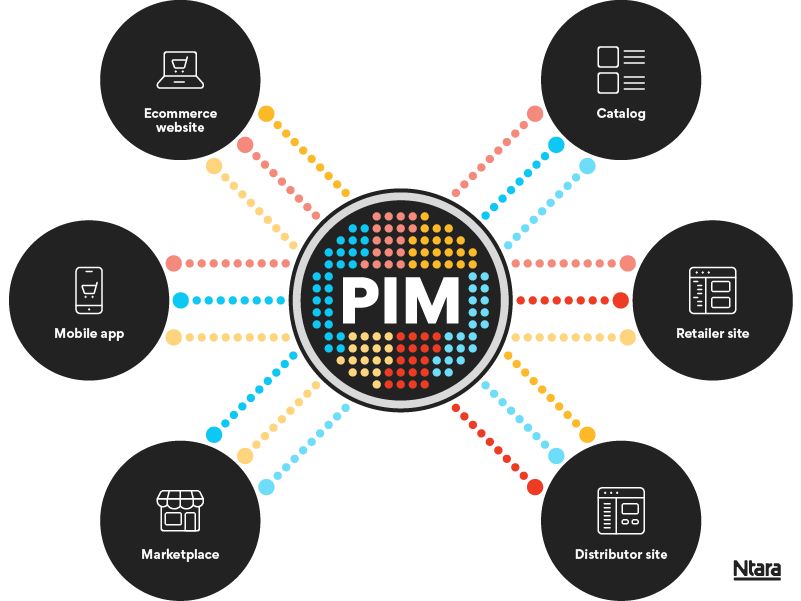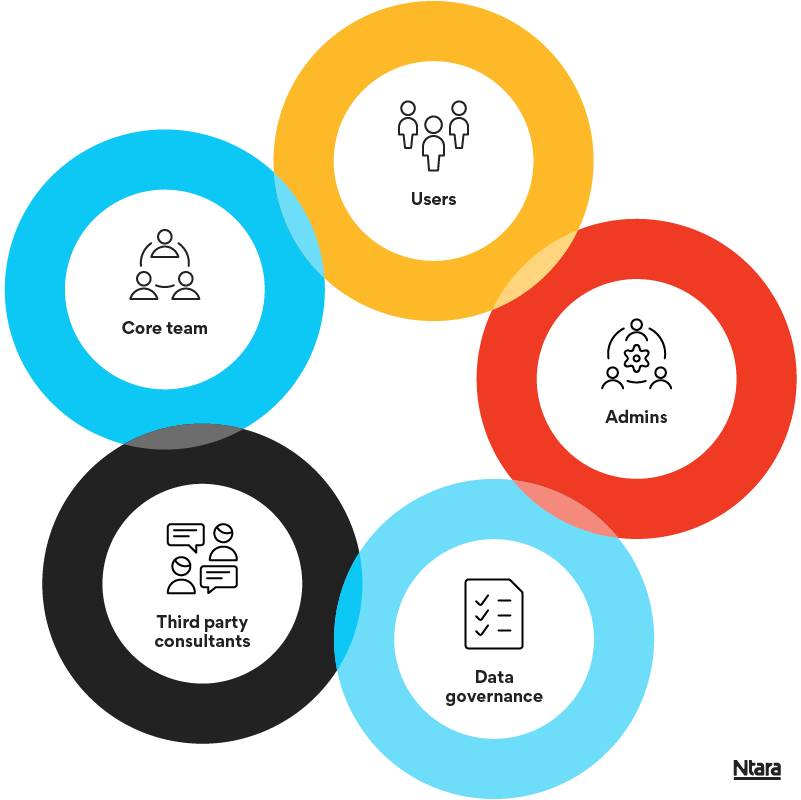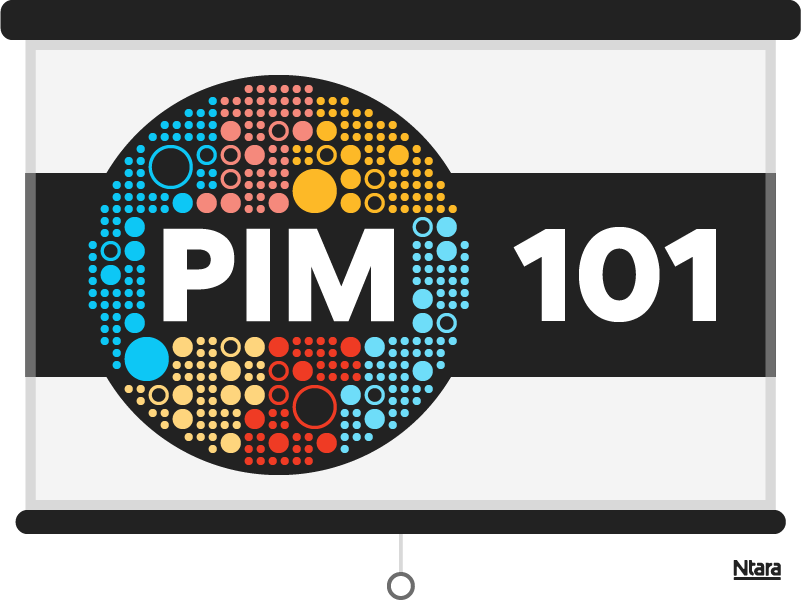The number of marketing technology (or martech stack) options can be overwhelming. In 2020 it was estimated that there were over 8,000 solutions to choose from. These tools optimize and automate your advertising, social, commerce, content, and data management.
Of these solutions, product information management (PIM) is the catalyst for ecommerce sales. PIM is the fundamental platform supporting all other product marketing functions. It centralizes content management and distribution across all digital channels.
PIM is key to transforming how you operate and bring products to market. It is the hub of your tech stack that impacts your entire digital ecosystem. A successful PIM software implementation yields many rewards.
- Increased efficiencies
- Cost savings
- Improved product accuracy
- Enhanced user experience (UX)
- Increased speed to market

IT and marketing teams work together to evaluate and manage PIM. Their efforts have cascading impacts across the organization.
Big impact projects aren’t always easy. Gartner reveals that digital transformations are taking longer and costing more than expected. This realization during or after a PIM software implementation can be especially frustrating.
At Ntara, we are honest about the efforts that go into PIM and the value you can expect. Our goal is to set you up for success. To do this, we help you plan and communicate what’s needed for a successful implementation.
Consider this direction for your team. It’s not enough to get through a change. You must develop an agile, iterative approach. PIM should evolve as your business grows. With this mindset, you will get the more from your system and create more impactful content. Innovation never stops and successful companies should expect change management to be ongoing.
“The secret of change is to focus all of your energy not on fighting the old, but on building the new.” – Socrates
We’ve seen successes and struggles with PIM software implementations. We do start-to-finish projects and we’ve done our fair share of rescue projects.
Maybe you’ve inherited a PIM. Or you now realize that the platform you built isn’t working or wasn’t adopted as expected. Don’t let this deter you.
We’ve become a go-to agency for reassessing and rebuilding PIM software. And we’ve distilled our experience into five key roadblocks and our secrets to overcome them.
PIM tip #1: Don’t oversimplify
PIM starts with choosing from a long list of PIM software. Each has its benefits and unique features. The PIM software you choose gets you started. Maybe the user-friendly interface, excitement over data automation, or the promise of a quick initial setup sold you. Those are all great reasons, but short- and long-term plans for PIM are critical.
PIM is often oversimplified. It may seem like a magical solution that will solve all problems. While it does impact many areas of your business, and we have amazing ROI success stories, it’s not an easy button.
Once your data is in PIM, it may not look like the demos you’ve seen. Missing imagery or more complicated product categories will have an impact. After the initial launch, you may need to enhance your product assets or optimize your PIM.
The best setup for one business won’t be the same for another. For example, you may have many ERPs or suppliers providing crucial data. Some, all, or none of it may need to be editable in PIM. Your retail partners may have different requirements. And your product page content may be the same or different on B2B and B2C channels.
An implementation partner, like Ntara, works with you to understand your digital ecosystem. We plan a custom solution for you based on your business goals and your platform’s modules. The launch is just the beginning.
It’s important to start small and use the PIM software to develop your requirements further. Your primary goal may be to centralize all product data or to send your catalog content to a single site. You might need more users, workflow logic, or syndication to more marketing channels with time.
A transformative project like this is a marathon, with mini sprints building out and testing a set of features at a time. Set your teams’ expectations for a long-term solution and not a quick fix.
PIM tip #2: Don’t over complicate
Sometimes we work with clients that have a “more is more” approach. My first PIM project was this way. Many well-meaning, excited stakeholders can have varying interests and requirements. It’s easy to get excited about all the bells and whistles that can go into a PIM. Your team should dream big and consider all options.
You may also think it’s best to get your money’s worth with your implementation partner. But building the most complex system out of the gate isn’t a best practice. Our advice is an iterative approach that redefines the minimal viable product (MVP) with each release.
Don’t spend all your time upfront overcomplicating your project. Go live, test, and make improvements over time to ease more pain points and save money in the long run. Let PIM drive your business (with increased sales and decreased costs) and help pay for itself.
This may sound like Goldilocks. It can’t be too small or too big. The truth is, it’s a balancing act. Every feature has requirements, user stories, development time, and user acceptance testing (UAT). PIM facilitates speed to market, but it can’t do that if you multiply your timeline to get it launched. Just as a business needs a website, the number of helpful tools and information it houses can and should evolve over time.
PIM tip #3: Have dedicated resources
A PIM project requires dedicated resources. Without roles and ownership, planning and managing PIM can get confusing. There are several teams to consider before, during, and after a PIM launch.
- Core team – Choose representatives from cross functional teams that will rely on PIM. Have them create a project charter, pick a platform, a consultant, and support the implementation. They will work to define requirements, project phases, and help with testing and internal communications.
- Users – Consult primary users during all stages of implementation. Find out what they’re doing now, what their pain points are, and what they need to get quality content to market. Build PIM to support their work and make their jobs more strategic and creative, less manual. Once PIM is live, ask them for feedback to optimize the tool for greater efficiencies.
- Admins – This is often overlooked. A large enterprise needs full-time internal PIM admin(s). We see clients try to set it and forget it. You need an owner to manage user access, field updates, new product needs, and new channels. This can be a super user on your content team, a tech lead in IT, or a PMO point person that manages marketing systems. Consider your options and choose what’s best for your business.
- Data governance – Form an ongoing committee to monitor data ownership. This group can work outside of PIM over many systems. But when an admin change is “needed” in your system, it should go through this team. They set criteria for data origins, owners, and help avoid redundancy or unnecessary complexity. Learn more about data governance.
- Third party consultants – Evaluate and partner with the best systems integrator (SI) for your company. You have options. Interview several consultants. Choose one that specializes in your industry or has experience with a similar setup. They will guide you strategically and provide PIM trained business analyst and development experts that most companies rarely have in-house. Make sure they work well with the team and fit with your culture. An SI should be an extension of your team, helping with all stages of the project. Work with them to evaluate platforms, map your digital journey, implement PIM, develop custom integrations, or facilitate user training and documentation.

PIM tip #4: Prioritize training
PIM is going to be a new way of working for your team. Change is good, but it can be an adjustment. Consider your go-to-market process before and after implementation. Think of all the departments and people that need to be aware of these changes. Most should find that their manual processes have been streamlined and work is different, but easier.
Start with PIM 101. The team should know what PIM is and why it’s part of your business process. This is a good refresher for your seasoned employees and a great orientation for new hires.

Document training for each user role. Create written and video instructions to share over time. Hold training sessions for demonstrations, questions, and round table exercises. Get a team together that represents different responsibilities in your product marketing journey. Have them bring a laptop and talk through their process. From product origination to copywriting, approvals, and syndication. Everyone can discuss and share what they’re seeing on their screen in real time.
PIM tip #5: Create a communication plan
Before PIM is in place, your core team should manage a planning schedule. Have them include tasks to prepare for the project and give regular updates. It’s important to keep leadership and stakeholders up to speed on evolving features and rollout schedules.
During the project analysis, interview SMEs to gather information for the project. Share with them why their input is necessary. The core PIM team should gather all requirements and outline how they’ll fit in the phased implementations. Provide clarity on what will be in the initial launch or future phases. Plan time for representatives of use cases to take part in user testing for those features.
Repeat, repeat, repeat. Just as your web team gives updates on their digital strategy, communicate each evolution of the PIM. It impacts your team and your customers. When you add new channels or your governance committee makes important decisions, roll those out to the company.
Having a regular communication plan helps you maintain the integrity of the project. The investment of time and resources shouldn’t go unnoticed. Encourage everyone to learn from the process, champion continuous improvement, and celebrate successes.
Transform your business with PIM
This may sound like a lot of work. As I mentioned earlier, it is. But it’s an investment that pays off. PIM is the foundation for streamlining process, broadening reach, and creating better content. It gives you more consistent, accurate, on brand, impactful content that converts browsers to buyers.
Digital transformation needs both executive leadership support and bottom-up ownership. When everyone is aligned on how and why to follow new operating procedures, it will change your whole organization for the better.